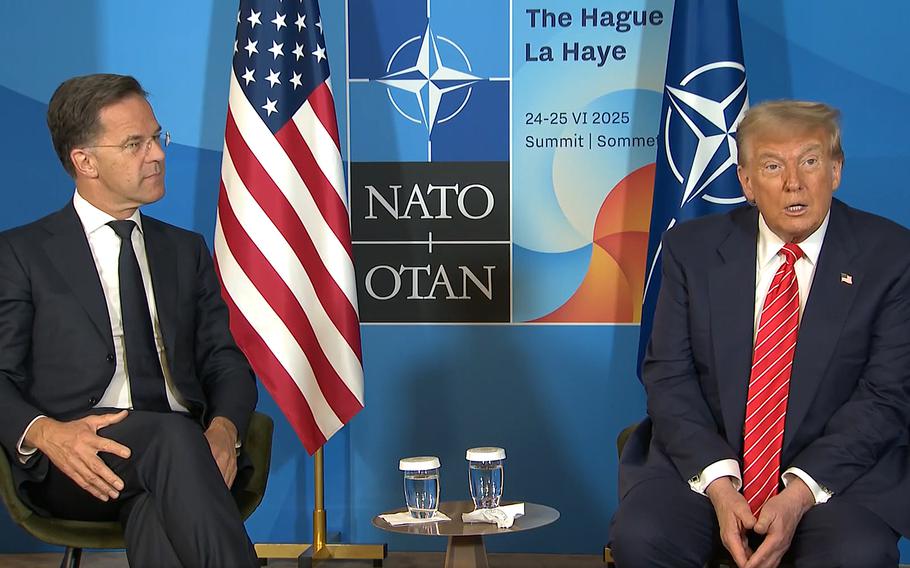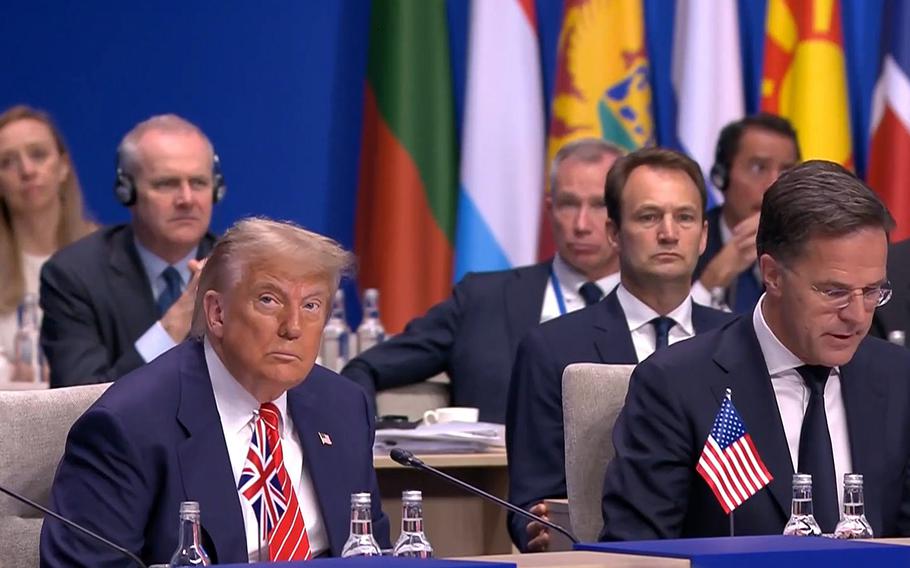
In this screenshot, NATO Secretary-General Mark Rutte listens to President Donald Trump on June 25, 2025. Rutte and Trump made short remarks before the day’s meetings at the NATO summit in The Hague, Netherlands, got underway. (NATO)
President Donald Trump on Wednesday hailed NATO’s push to increase defense spending at the start of a high-level summit, where he also pushed back against reports that U.S. bombing strikes on Iran’s nuclear program had failed to deliver a knockout blow.
“It was a complete obliteration,” Trump said of the Saturday strike in Iran.
Trump’s comments at the NATO gathering in the Dutch city of The Hague came after reports that Saturday’s bombardment had set Iran’s nuclear program back by only a couple of months.
An assessment by the administration’s Defense Intelligence Agency determined that the attack did not completely destroy Iran’s program, according to reporting by The Associated Press and other news agencies on Tuesday.
But Trump, flanked by NATO Secretary-General Mark Rutte, said that such reports are false and that Iran’s nuclear ambitions were set back “decades.”
“I don’t think they’ll ever do it again. … I think they’ve had it,” Trump said. “I mean, they just went through hell. I think they’ve had it. The last thing they want to do is enrich.”

In this screenshot, President Donald Trump listens to NATO Secretary-General Mark Rutte at the beginning of a meeting of the North Atlantic Council during the NATO summit in The Hague, Netherlands, June 25, 2025. (NATO)
Trump also said the U.S. strike on Iran paved the way for a ceasefire between Israel and Iran.
“This ended that with the war,” he said.
The U.S. attack on Iran and the broader conflict between Tehran and Israel have overshadowed what was billed as a historic NATO summit in The Hague, where leaders on Wednesday approved a plan for major defense spending increases inside the alliance.
Trump, who has delivered tough critiques of NATO over the years, praised allies for meeting his demand to spend much more on defense.
During his first term, Trump frequently voiced doubts about the alliance’s value and characterized the bloc as a collection of security free riders because of their weak defense spending. On Wednesday, he said his outlook has changed.
“It’s not a rip-off, and we’re here to help (allies) protect their country,” Trump said of the 32-nation pact.
When asked about the U.S. commitment to NATO’s Article 5 provision that calls for allies to come to one another’s defense in the event of an attack, Trump said, “I stand with it. That’s why I’m here. If I didn’t stand with it I wouldn’t be here.”
A day earlier, Trump delivered a more ambiguous message on NATO’s mutual defense pact. When asked whether he backed the linchpin NATO concept, Trump said, “depends on your definition. There’s numerous definitions of Article 5.”
Rutte, who has credited the American president with being the force behind NATO’s increased spending, said he is convinced of Trump’s support for the alliance.
“For me, there is absolute clarity that the United States has totally committed to NATO, totally committed to Article 5,” Rutte said Wednesday.
Rutte also heaped praise on Trump, saying his election was the reason that close to 10 NATO countries finally hit the 2% mark this year.
Other factors, namely Russia’s full-scale invasion of Ukraine in 2022, also have been a major contributor to increased defense spending in Europe over the past several years.
“Given our long-term threat of Russia but also the massive buildup of the military in China and the fact that North Korea, China and Iran are supporting the war effort in Ukraine, it’s really important we spend more,” Rutte said.
NATO’s new 5% plan includes a target date of 2035, when members are supposed to reach the mark. Spain, however, has said it won’t achieve that threshold. Trump singled the country out for criticism, saying there would be consequences.
“We’re going to make them pay twice as much. ... They want a little bit of a free ride, but they’ll have to pay it back to us on trade,” Trump said.
Trump said all other allies were on board with the 5% plan.
The program means that countries must spend 3.5% of GDP on traditional military capabilities, such as tanks and ammunition, while 1.5% would go to military-related infrastructure. Some analysts have described the formula as a workaround to get to Trump’s 5% demand.
It’s unclear how NATO will define military infrastructure. The alliance also didn’t say what consequences, if any, there would be if allies fail to hit the spending target.
Still, the agreement marks a major turn for many of the alliance’s militaries, which for years fell well short of the 2% level.
“For too long, one ally, the United States, carried too much of the burden of that commitment,” Rutte said. “And that changes today.”
The U.S. currently spends about 3.4% of GDP on defense. Rutte said he considers the United States to already be at NATO’s 5% level, saying American investments in military-related infrastructure easily make up the difference.
After the meetings, Rutte was questioned by reporters about his various flattering statements on Trump’s leadership.
“Doesn’t he deserve some praise?” Rutte answered.
The issue of defense spending has dominated Trump’s approach to NATO and has put him at odds with numerous countries, most notably Germany.
The situation came to a head during Trump’s first term, when he publicly bashed allies during a 2017 NATO summit for their shortcomings, stoking fears in Europe that the U.S. could quit the alliance.
Berlin, however, met NATO’s 2% level for the first time in decades in 2024. And Chancellor Friedrich Merz also has been vocal about the need to increase expenditures.
That has won Germany praise from several U.S. leaders, including Defense Secretary Pete Hegseth and Matthew Whitaker, the U.S. ambassador to NATO. In a statement after talks Wednesday, Merz said the spending increases are not about doing Trump a favor.
“Russia is threatening the entire political order of our continent,” he said. “Particularly Europe needs to step up its efforts to ensure its own defense.”
This story has been updated.